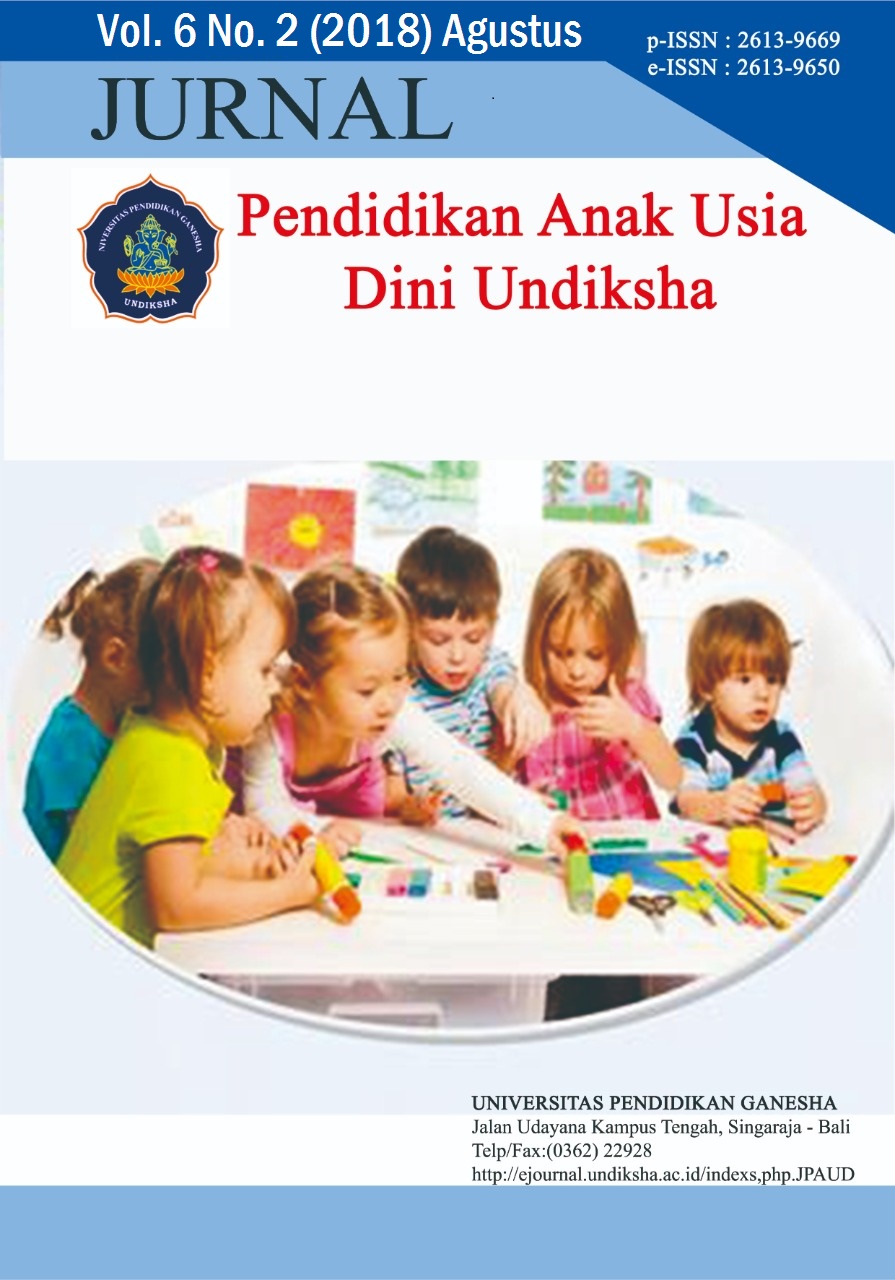PENGARUH MODEL PEMBELAJARAN PROJECT BASED LEARNING TERHADAP KEMAMPUAN MOTORIK HALUS ANAK KELOMPOK A GUGUS VI
DOI:
https://doi.org/10.23887/paud.v6i2.15319Abstract
Penelitian ini bertujuan untuk mengetahui pengaruh model pembelajaran berbasis proyek terhadap kemampuan motorik halus. Penelitian ini menggunakan desain quasi experimen dengan rancangan non equivalent post tes only control group design. Populasi yang digunakan dalam penelitian ini adalah seluruh kelompok A di gugus VI Kecamatan Buleleng yeng berjumlah 224 orang. Sampel yang digunakan dalam penelitian ini adalah TK Aisiyah Bustanul Athfal Singaraja dengan jumlah siswa sebanyak 48 orang sebagai kelompok eksperimen dan RA Ath-Thooriq Singaraja dengan jumlah anak 49 orang sebagai kelompok kontrol. Data penelitian ini dikumpulkan dengan menggunakan metode observasi. Dari hasil uji normalitas dan homogenitas varians, diketahui bahwa sampel berdistribusi normal, dan varian populasi bersifat homogen maka untuk menguji hipotesis digunakan uji-t dengan taraf signifikansi 5%. Hasil perhitungan uji-t menemukan bahwa hasil thitung =12,96 dan ttabel =2,021 pada taraf signifikasn 5% dengan dk=34, dengan demikian hasil thitung dengan ttabel dapat disimpulkan bahwa thitung>ttabel, maka H0 ditolak dan H1 diterima, sehingga hasil penelitian ini menunjukkan bahwa terdapat pengaruh yang signifikan model pembelajaran berbasis proyek terhadap kemampuan motorik halus pada kelompok A di Taman Kanak-Kanak Gugus VI Kecamatan Buleleng.Kata Kunci : anak usia dini, kemampuan motorik halus, model proyek
This study aims to determine the effect of project-based learning model on fine motor skills. This research uses quasi experiment design with non equivalent design post test only control group design. The population used in this study is the entire group A in cluster VI District Buleleng yeng amounted to 224 people. The sample used in this research is Aisiyah Bustanul Athfal Singaraja kindergarten with 48 students as experiment group and RA Ath-Thooriq Singaraja with 49 children as control group. Data of this research were collected by using observation method. From normality test result and homogeneity of variance, it is known that sample is normal distribution, and variant of population is homogeneous hence to test hypothesis used t-test with 5% significance level. The result of t-test shows that the result of tct = 12,96 and ttable = 2.021 at 5% significance level with dk = 34, thus thitung result with ttable can be concluded that thitung> ttable, then H0 is rejected and H1 accepted, this indicates that there is a significant effect of project-based learning model on fine motor skills in group A in Kindergarten VI District Buleleng Park.
keyword : early childhood, fine motor skills, project model
Published
2018-07-27
How to Cite
., F. M., ., D. I. I. W. S., & ., M. M. S. M. (2018). PENGARUH MODEL PEMBELAJARAN PROJECT BASED LEARNING TERHADAP KEMAMPUAN MOTORIK HALUS ANAK KELOMPOK A GUGUS VI. Jurnal Pendidikan Anak Usia Dini Undiksha, 6(2), 189–198. https://doi.org/10.23887/paud.v6i2.15319
Issue
Section
Articles
License
Authors who publish with the Jurnal Pendidikan Anak Usia Dini Undiksha agree to the following terms:
- Authors retain copyright and grant the journal the right of first publication with the work simultaneously licensed under a Creative Commons Attribution License (CC BY-SA 4.0) that allows others to share the work with an acknowledgment of the work's authorship and initial publication in this journal.
- Authors are able to enter into separate, additional contractual arrangements for the non-exclusive distribution of the journal's published version of the work (e.g., post it to an institutional repository or publish it in a book), with an acknowledgment of its initial publication in this journal.
- Authors are permitted and encouraged to post their work online (e.g., in institutional repositories or on their website) prior to and during the submission process, as it can lead to productive exchanges, as well as earlier and greater citation of published work. (See The Effect of Open Access)











